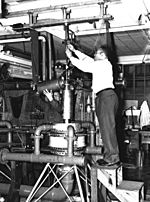Warren Elliot Henry facts for kids
Quick facts for kids
Warren Elliot Henry
|
|
|---|---|

Henry performing research at cryogenic temperatures in NRL's high magnetic field facility
|
|
| Born | February 18, 1909 |
| Died | October 31, 2001 (aged 92) |
| Nationality | American |
| Alma mater | Tuskegee Institute, Atlanta University, University of Chicago |
| Scientific career | |
| Fields | physics of magnetism and superconductivity |
| Institutions | Tuskegee Institute, U.S. Naval Research Laboratory, Howard University |
Warren Elliot Henry (February 18, 1909 – October 31, 2001) was an American physicist, a Fellow of the American Physical Society, and the American Association for the Advancement of Science for his work in the fields of magnetism and superconductivity. He made significant contributions to the advancement of science and technology and education, training and mentoring several generations of physicists.
Early life and education
Henry was born in Evergreen, Alabama in 1909. Dr. Henry attended Tuskegee Institute, as his parents had done. He majored in Mathematics, English, and French, and graduated in 1931 with a Bachelor of Science. Prior to continuing his studies, he served as a school principal at a segregated school in Ardmore, Alabama. Henry earned a Master of Science degree in organic chemistry from Atlanta University in 1937. While working towards his graduate degree, he taught classes at Spelman College and Morehouse College. He received a Ph.D in Physical Chemistry from the University of Chicago in 1941.
Professional life
After graduating, Henry returned to Tuskegee Institute where he taught courses. Some of his students were the 99th Pursuit Squadron, part of the Tuskegee Airmen.
From 1943 to 1946, Henry found a position at MIT's Radiation Laboratory. Following that, he worked in a postdoctoral position with Clarence Zener at the Institute for the Study of Metals at the University of Chicago.
Henry later worked as a physicist at the U.S. Naval Research Laboratory from 1948–1960, as an engineer and scientist at Lockheed Missiles and Space Co. until 1969, then as a professor of physics at Howard University. During his time at Lockheed, he also performed experiments on magnetic susceptibility at the University of California, Berkeley. He authored dozens of scientific articles.
Henry formally retired in 1977, but he continued to devote his time to research and encouraging and helping new generations of scientists . He travelled worldwide giving talks and presentations and worked for years with the Minorities Access to Research Careers (MARC) program, established in 1975 by the National Institutes of General Medical Sciences. Henry founded the Committee on Minorities in Physics of the American Physical Society and was an early leader of the National Society of Black Physicists.
In an obituary written on November 10, 2001, the New York Times states "Dr. Henry studied under a number of Nobel Prize winners: Dr. Arthur H. Compton, the 1927 winner in physics, taught him quantum mechanics; Dr. Wolfgang Pauli, the 1945 winner, taught him the theory of nuclear forces; Dr. Robert A. Millikan, the 1923 winner, taught him molecular spectra. In addition, he played tennis with Dr. Enrico Fermi, a 1938 laureate."
Awards and recognitions
Henry was a Fellow of the American Physical Society, and the American Association for the Advancement of Science. For 1974-75, he received the Outstanding Educator in America. He was the recipient of the Lifetime Achievement Award in the Community from the National Science Foundation, and the 1997 Technical Achiever Award of the Year from the National Technical Association. In 1997, he was awarded the 1st Annual Golden Torch Award for Lifetime Achievement in Engineering, bestowed by the National Society of Black Engineers. In 1999, his alma mater, the University of Chicago, awarded Henry a professional achievement citation to recognize his contributions to cryogenics and magnetism.

